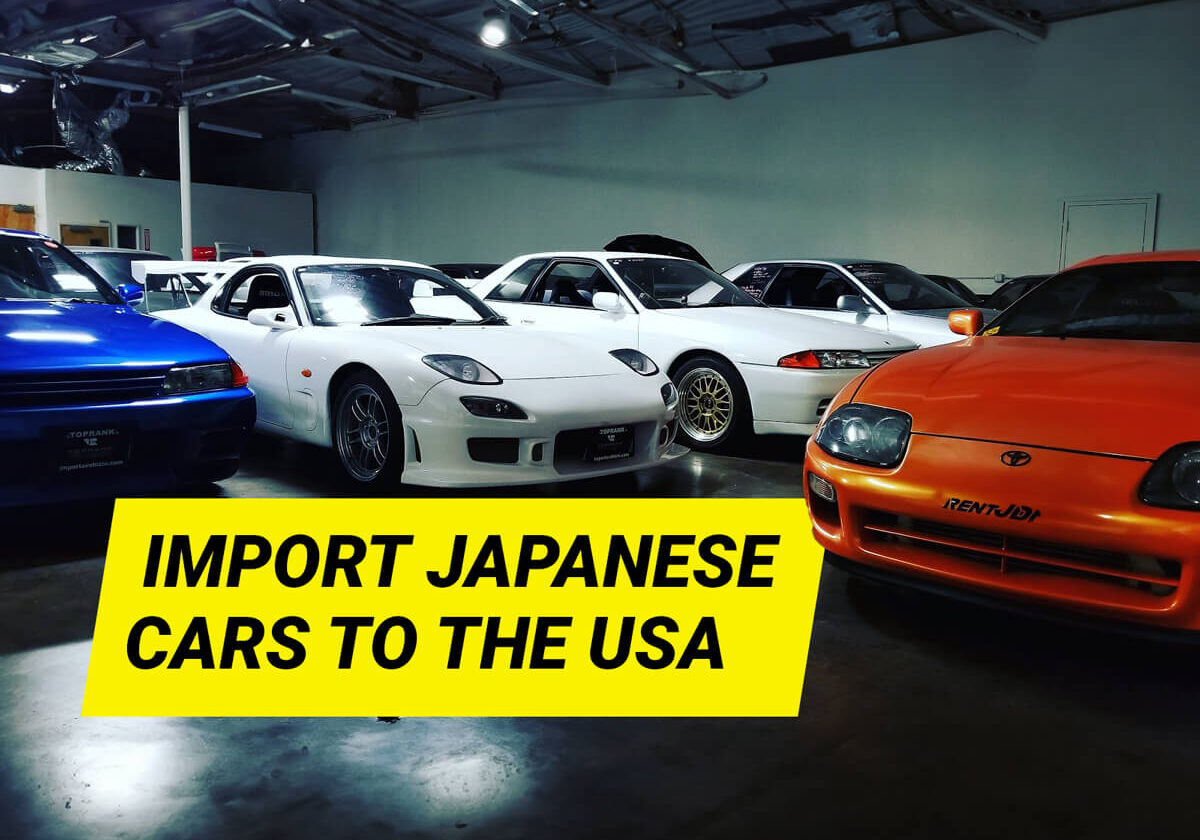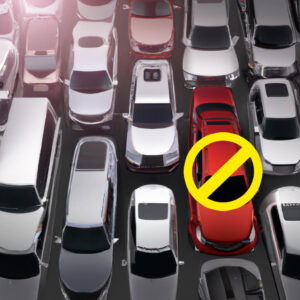Importing a JDM Car to the USA
So you want to import your favorite JDM car to the US. Here's how you do it.
Updated: November 16, 2023 // Buying

Key takeaways for importing a JDM car
- Importing a Japanese car into the US offers car enthusiasts the opportunity to acquire unique and high-quality vehicles, but it requires careful consideration and planning.
- Many options exist for importing a JDM car, including making the car compliant with US regulations, finding a similar car already sold in the US, utilizing the "Show or Display" rule, waiting 25 years for easier importation, or engaging an experienced importer.
- Following a series of steps, such as determining the desired car, checking dealers' inventory, completing the buying process, ensuring compliance with federal requirements, and addressing post-purchase work and roadworthiness, is essential for a successful importation.
- State-specific challenges, particularly in California, such as strict emissions requirements and specific importation rules for certain time frames, must be considered and navigated effectively. But importers who know those rules can really help make sure bringing cars into California goes smoothly.
So You Want To Import a JDM Car
Importing a Japanese (JDM) dream car into the United States can be an exciting endeavor for car enthusiasts seeking unique and high-quality vehicles. But, there are a bunch of things to think about and steps you've got to follow in this process. So, we're gonna break down the steps and give you top-notch tips on how to smoothly bring a Japanese car into the US, tackling any roadblocks and staying within legal lines.
Understanding Your Options
When it comes to importing a Japanese car into the US, you have more options than you might think.
Option 1. Making the Car Compliant with US Regulations
One approach involves aligning the Japanese car with US regulations. Although you get the liberty to pick any car you fancy, it might be a drain on your wallet and eat up a lot of your time. To fit the US standards, you may need to give your car a bit of an upgrade - think better lights, more safety gear, or even eco-friendlier emission systems.
Option 2: Finding a Similar Car Already Sold in the US
Another strategy entails searching for a comparable car already available in the US market. This simplifies the importation process since the car would already conform to US regulations.
Option 3. The "Show or Display" Rule
The "Show or Display" rule offers a pathway for importing exclusive Japanese cars into the US. But the "Show or Display" rule only lets you import rare, historically significant cars—not popular models—if they don't meet US standards.
Option 4. Waiting 25 Years for Easier Importation
If you're willing to wait, importing a Japanese car becomes significantly easier after 25 years. Once a car attains this milestone, it becomes exempt from crash tests and emissions requirements, streamlining the importation process. his allows JDM automobiles, which frequently don't satisfy US safety standards, to be imported and registered. The exception also applies to left-hand drive versions offered in Japan by BMW and Mercedes-Benz, giving JDM car fans more alternatives.
Option 5. Engaging an Experienced Importer
Importing a car independently can be a daunting endeavor due to the intricate paperwork and potential complications involved. To streamline the process and ensure a seamless importation experience, it is highly advisable to enlist the services of a seasoned car importer, such as the esteemed JDM Legends. These seasoned pros have the chops and network to help you navigate through the intricate car import process like a breeze.
8 Steps to Legally Import a Japanese Car
Now that we have explored the various available options, let us delve into the specific steps required to legally import a Japanese car into the US. By following these steps, you can ensure compliance with federal requirements and significantly enhance the likelihood of a successful importation:
1. Determine the Desired Car
The initial step is to pinpoint the precise Japanese car you aspire to import. Dive deep into your research, weighing up choices based on things like the car's make, model, year and condition alongside what you personally want in a ride. This will aid in narrowing down your choices and providing a clear vision of the JDM car you intend to import.
2. Check the Inventory of Dealers
Once you have determined the desired car, assess the inventory of reputable dealers who specialize in Japanese car imports. You'll find these dealerships offer a wide variety of cars, and they're pretty good at guiding you through the ins and outs of importing.
3. Join Waiting Lists if Necessary
In certain cases, particularly for highly sought-after models, you may need to secure a place on a waiting list to ensure the opportunity to purchase your preferred car. Stay in touch with the dealership, let them know you're really keen - they'll clue you in on when and how your dream car can hit the road.
4. Complete the Buying Process
When purchasing a Japanese car from an importer like JDM Legends, the buying process closely resembles that of purchasing from a dealership. Ensure that all necessary paperwork, including the bill of sale, import documentation, and customs forms, are thoroughly and accurately completed and signed. This establishes legal ownership and facilitates a seamless transition of the car's title.
5. Compliance with Federal Requirements
One of the significant advantages of purchasing from a reputable importer like JDM Legends is their unwavering commitment to ensuring compliance with federal requirements. JDM Legends really makes sure all the boxes are checked for safety, emission standards, and regulations—giving you a hassle-free import process and total peace of mind.
6. Utah-Issued Title for Simplified Registration
Upon purchasing a Japanese car from JDM Legends, you will receive a title issued by the state of Utah. Having a Utah title in hand really helps, especially when you're dealing with tough states like California because it streamlines the whole car registration deal. Having a Utah title in hand gives you the upper hand by making sure your car ticks off all federal requirements, simplifying that headache-inducing registration process.
7. Post-Purchase Work and Roadworthiness
After acquiring the Japanese car, certain modifications may be necessary to ensure its roadworthiness and full compliance with US standards. If you're looking to get your Japanese import up to US standards, JDM Legends is the expert in fine-tuning and adjusting for safety, emissions, and performance. This stage is key in making sure you can legally hit the road with your imported ride on US soil.
8. Title Transfer and Insurance
Transferring the car's title at the Department of Motor Vehicles (DMV) constitutes a vital step in the importation process. Prepare the required documentation, including the bill of sale, customs forms, and any other relevant paperwork, to facilitate a smooth title transfer. Also, you gotta make sure to get your ride insured once it's imported - that's a must-do. Insurance companies may require a professional appraisal to accurately ascertain the vehicle's value.
Related: 10 Best Cheap JDM Project Cars
Addressing State-Specific Challenges
While the general importation process applies universally, individual states, particularly California, impose specific challenges and requirements. Let us examine these hurdles and explore strategies to navigate them successfully:
California's Emissions Requirements
Importing a Japanese car into California poses unique challenges due to the tough emissions requirements mandated by the California Air Resources Board (CARB). You'll need to team up with an importer who really knows their stuff about California rules and can make sure your Japanese car meets the strict emission standards. This expertise will enable you to navigate the complex regulatory landscape adeptly and ensure compliance with California's rigorous guidelines.
Importation Rules for Cars Manufactured between 1968 and 1974
California has specific importation rules governing cars manufactured between 1968 and 1974. To get these cars into California, they've gotta pass some pretty tough emissions tests. It is imperative to comprehend and adhere to these requirements when considering the importation of Japanese cars falling within this time frame.
Exemptions for Cars Manufactured in 1967 or Earlier
Cars manufactured in 1967 or earlier are exempt from emissions testing and most other importation requirements in California. If you are interested in importing a vintage Japanese car falling within this exemption, you can enjoy a more straightforward importation process. But, you've gotta make sure the whip meets all safety rules and sticks to any other important regs.
Importing JDM Cars Bottom Line
Importing a Japanese car into the US is an exhilarating pursuit for car enthusiasts who desire unique and superior-quality vehicles. By getting a good grip on your options, meticulously tackling each step and skillfully handling any state-specific hiccups, you'll smoothly sail through this intricate process. Engaging the services of an experienced importer, such as the renowned JDM Legends, streamlines the importation process, ensuring compliance with federal requirements and enhancing your overall importation experience. Dedicate ample time to research, meticulous planning, and collaboration with reputable experts to bring your dream Japanese car to American roads legally.
Importing Japanese Cars FAQs
JDM stands for Japanese Domestic Market, referring to vehicles originally manufactured and sold in Japan. People are getting really into JDM cars because they've got cool looks, high-tech features, and top-notch quality. Importing JDM cars allows enthusiasts to experience a wider range of models, performance options, and customization possibilities not typically available in their local markets.
Getting help from an expert car importer has a lot of benefits. Importers who know how the process works can give expert advice, make paperwork and documentation easier, make sure they meet federal requirements, handle state-specific problems, and have the links they need to find and import JDM cars quickly. Their savvy smooths out bumps, making the entire JDM car importation a breeze.
Importing a JDM car involves several important considerations. These include compliance with US regulations, such as safety and emissions standards, determining the availability and condition of the desired car, understanding importation options (such as making the car compliant, finding similar cars already sold in the US, utilizing the "Show or Display" rule, or waiting for the 25-year exemption), and addressing state-specific challenges like California's emissions requirements.
The time it takes to import an automobile varies on the importation method, the car's availability, compliance requirements, and paperwork and logistics.
Importing a JDM car can take anywhere from a few weeks to a few months, depending on how long it takes to make changes, test for compliance, and handle paperwork. Hiring a professional importer should speed up and streamline the process.
Disclaimer: The writers of this article may have used artificial intelligence to help them with some of the material. It should not be a replacement for professional help.







